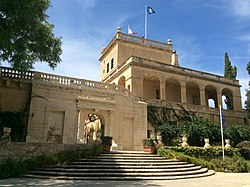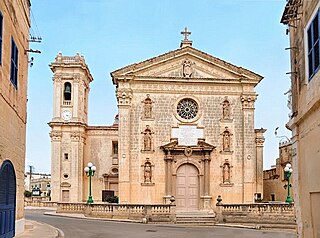
Attard is a town in the Central Region of Malta. Together with Balzan and Lija it forms part of "the Three Villages" and has been inhabited since the Classical Period. It has a population of 12,268 as of 2021. Attard's traditional Latin motto is Florigera rosis halo due to its many flower gardens and citrus orchards. Attard is abundant in public gardens. The inhabitants of Attard are known as saraċini.

Floriana, also known by its title Borgo Vilhena, is a fortified town in the Port Region area of Malta, just outside the capital city Valletta. It has a population of 2,205 as of March 2014. Floriana is the birthplace of many famous Maltese, amongst which the composer of the national anthem, 'L-Innu Malti', Robert Samut; former Bishop of Malta Dun Mauro Caruana, the poets Oliver Friggieri and Maria Grech Ganado, the writer and politician Herbert Ganado and Swedish Idol winner Kevin Borg.
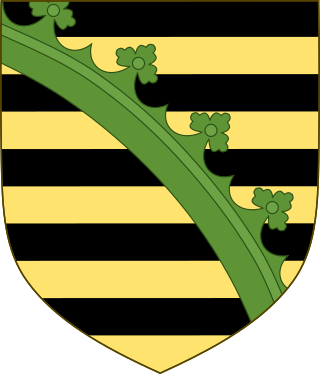
The House of Wettin was a dynasty which included Saxon kings, prince-electors, dukes, and counts, who once ruled territories in the present-day German federated states of Saxony, Saxony-Anhalt and Thuringia. The dynasty is one of the oldest in Europe, and its origins can be traced back to the town of Wettin, Saxony-Anhalt. The Wettins gradually rose to power within the Holy Roman Empire. Members of the family became the rulers of several medieval states, starting with the Saxon Eastern March in 1030. Other states they gained were Meissen in 1089, Thuringia in 1263, and Saxony in 1423. These areas cover large parts of Central Germany as a cultural area of Germany.

Gżira is a town in the Central Region of Malta. It is located between Msida and Sliema, also bordering on Ta' Xbiex. It has a population of 11,699 as of January 2019. The word Gżira means "island" in Maltese, and the town is named after Manoel Island which lies to the east of Gżira, between the Sliema peninsula and Valletta. The seafront of Gżira has views of the walled city of Valletta, which is illuminated at night, forming a backdrop to Manoel Island, the yacht marina and a seafront public garden. The hamlet of Kappara is located close to Gżira. The Orpheum Theatre is located in Gżira.

António Manoel de Vilhena was a Portuguese nobleman who was the 66th Prince and Grand Master of the Order of St. John of Jerusalem from 19 June 1722 to his death in 1736. Unlike a number of the other Grand Masters, he was benevolent and popular with the Maltese people. Vilhena is mostly remembered for the founding of Floriana, the construction of Fort Manoel and the Manoel Theatre, and the renovation of the city of Mdina.

Saxe-Coburg-Saalfeld was one of the Saxon Duchies held by the Ernestine line of the Wettin Dynasty. Established in 1699, the Saxe-Coburg-Saalfield line lasted until the reshuffle of the Ernestine territories that occurred following the extinction of the Saxe-Gotha line in 1825, in which the Saxe-Coburg-Saalfeld line received Gotha, but lost Saalfeld to Saxe-Meiningen.

The Grandmaster's Palace, officially known as The Palace, is a palace in Valletta, Malta. It was built between the 16th and 18th centuries as the palace of the Grand Master of the Order of St. John, who ruled Malta from 1530 to 1798, and was also known as the Magisterial Palace. When the knights were expelled by Napoleonic France, it became the National Palace. During the period of British rule beginning in 1800, it was the Governor's Palace.

Maltese architecture has its origins in prehistory, and some of the oldest free-standing structures on Earth – a series of megalithic temples – can be found on Malta. The islands were colonized by the Phoenicians and later the Romans, who established the cities of Melite and Gaulos. Although these were substantial settlements and are known to have had numerous temples, churches and palaces, few remains have survived apart from some architectural fragments.
This page list topics related to Malta.
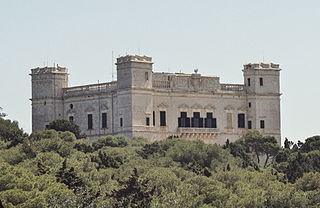
Verdala Palace is a palace in the Buskett Gardens, limits of Siġġiewi, Malta. It was built in 1586 during the reign of Hugues Loubenx de Verdalle, and now serves as the official summer residence of the President of Malta. The palace was previously a residence of the British governor of Malta, together with the San Anton Palace, and was often used by British sovereigns and other royalty during their stay in Malta.

The House of Saxe-Coburg and Gotha-Koháry is the Catholic cadet branch of the House of Saxe-Coburg and Gotha, founded after the marriage of Prince Ferdinand of Saxe-Coburg and Gotha and Princess Maria Antonia Koháry de Csábrág. Among its descendants were the last four kings of Portugal and the last three Tsars of Bulgaria. After the change of the “House laws” by Simeon II, the present head of the house is his sister Princess Marie Louise of Bulgaria, Princess of Koháry.
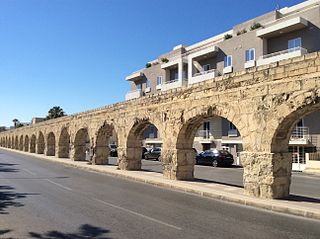
The Wignacourt Aqueduct is a 17th-century aqueduct in Malta, which was built by the Order of Saint John to carry water from springs in Dingli and Rabat to the newly built capital city Valletta. The aqueduct carried water through underground pipes and over arched viaducts across depressions in the ground.

Vilhena Palace, also known as the Magisterial Palace and Palazzo Pretorio, is a French Baroque palace in Mdina, Malta. It is named after António Manoel de Vilhena, the Grand Master who commissioned it. It was built between 1726 and 1728 to designs of the French architect Charles François de Mondion, on the site of the meeting place of the Università. The palace was used a hospital in the 19th and 20th centuries, and it became known as Connaught Hospital after 1909. Since 1973, it has been open to the public as Malta's National Museum of Natural History.

Selmun Palace, also known as Selmun Tower, is a villa on the Selmun Peninsula in Mellieħa, Malta. It was built in the 18th century by the Monte della Redenzione degli Schiavi, funded by the Monte di Pietà. The palace was located on the grounds of a hotel until it closed in 2011.
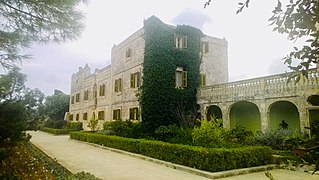
Girgenti Palace is a palace near Siġġiewi, Malta. It was built in 1625 as the summer residence of Malta's inquisitor, and is therefore also known as the Inquisitor's Palace. It is now an official residence of the Prime Minister of Malta.
Grand Master's Palace most often refers to:
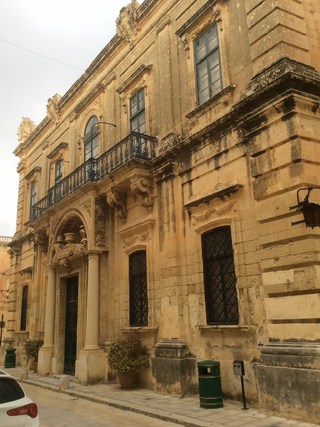
The Banca Giuratale, also known as the Municipal Palace, is a public building in Mdina, Malta. It was built in the 18th century to house the city's administrative council and courts, and was later used as a private residence and a school. It now houses part of the National Archives of Malta.
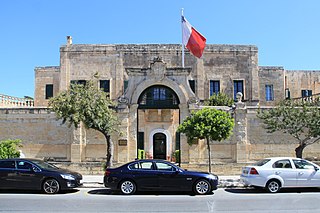
Casa Leoni or Casa Leone, also known as Palazzo Manoel or the Vilhena Palace, is a palace in Santa Venera, Malta, which was built as a summer residence for Grand Master António Manoel de Vilhena in 1730. It was subsequently used for a number of purposes, including as an insurgent command base, an official residence, a museum depository and a school. It currently houses the Ministry for Transport, Infrastructure and Capital Projects (MTIP).

Ġnien is-Sultan, also known as the Giardino della Marina, the Grand Master's Garden or Lascaris Garden, was a garden in Valletta, Malta. It was established in the 17th century by Giovanni Paolo Lascaris, and included a summer residence for the Grand Master. The garden included several Baroque elements designed by Francesco Buonamici.

The Svätý Anton manor house is a late baroque-classicist mansion constructed in 1744 with an English landscape garden park in Svätý Anton, Slovakia. It was one of the main residences of the Saxe-Coburg and Gotha-Koháry family. Both the mansion and park are open to the public.
